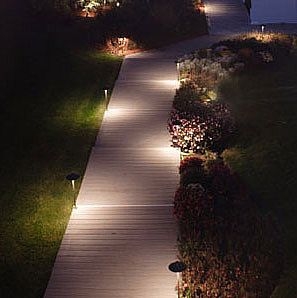Spacing Solar Powered Lighting
We are often asked how many solar powered lights a homeowner will need to light up a pathway or walkway. One small light will not do it, but how many solar path lights do you need and how much space should you leave between solar lights? In this article, we offer a few solar landscape lighting basics and some rules of thumb to help you decide. 
You will find that many of the approaches to placing solar lighting are not that different from placing ordinary landscape lighting. The twist with solar lighting is that wherever you place the solar light, it has to receive some direct sunlight or it will be unable to recharge itself. And you need to pay attention to how bright the particular brand of solar light is.
Related Article: Shedding Light On Solar Powered Lighting: How Long Will They Shine?
You will want to place your solar powered lights effectively to make sure you get the best coverage from them. If you're using the lights for small accents along a path, choose lights that give a smaller, softer light and space them farther apart. For a stronger light, position them closer together so that they overlap more. As a general rule, smaller profile lighting for residential use should be placed 6 - 8 feet apart while commercial applications that require more lighting should be placed 4 - 6 feet apart.
Before you purchase your solar powered lights, get a rough estimate of how many lights you will need by measuring your space and marking out where your solar lights will be placed. Aside from these few basic tips, landscaping design basically comes down to your personal preference and lighting needs. Experiment with these techniques and try your own ideas to achieve that great look solar lights can provide.
Uplighting: By positioning your solar light source on the ground, or below the object and pointing the beam upwards you can highlight walls, structures, and large plantings, which creates visual interest and dramatic focal points.
Downlighting: By positioning your solar light source high above the object and pointing the beam down, the light will be cast over a wide area like a patio. By locating a downward-facing solar light close to the ground, you can create softly spreading puddles of light ideal for walkways.
Grazing: Position your solar light close to an interesting surface. This will bring out its texture. Use grazing to highlight tree bark, stone walls, or an attractive door.
Silhouetting: By hiding solar lights behind and below a distinct landscape feature like a tree, you can create a silhouette that is visible against the sky at night.
Take note that too many lights around your property will make it look like a birthday cake with too many candles. Focus on quality rather than quantity to draw the eye towards specific areas, landscape features or structures. A common mistake is to evenly line both sites of a path or walkway with solar lights, making it look like the landing strip for a 747. A better way is to alternate your solar lights on either side of the path.
